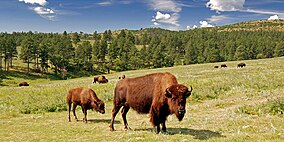Custer State Park
| Custer State Park | |
|---|---|
 American bison at the Wildlife Loop Road | |
 Location of Custer State Park in South Dakota | |
| Location | Custer, South Dakota, United States |
| Coordinates | 43°44′45″N 103°25′5″W / 43.74583°N 103.41806°WCoordinates: 43°44′45″N 103°25′5″W / 43.74583°N 103.41806°W |
| Area | 71,000 acres (290 km2) |
| Elevation | 4,721 ft (1,439 m)[1] |
| Established | 1912 |
| Named for | George Armstrong Custer |
| Governing body | South Dakota Department of Game, Fish & Parks (GFP) |
  |
| Southwestern South Dakota |
|---|
| Sculptures |
|
| Geologic and natural history |
| Mountains |
| Caves |
| Forests and wildernesses |
|
| Lakes |
| Scenic byways |
Custer State Park is a South Dakota State Park and wildlife reserve in the Black Hills, United States. The park is South Dakota's largest and first state park, named after Lt. Colonel George Armstrong Custer. The park covers an area of over 71,000 acres (287 km2) of varied terrain including rolling prairie grasslands and rugged mountains.[2]
The park is home to a herd of 1,500 bison.[3][2] Elk, coyotes, mule deer, white tailed deer, mountain goats, prairie dogs, bighorn sheep, river otters, pronghorn, cougars, and feral burros also inhabit the park. The park is known for its scenery, its scenic drives (Needles Highway and the wildlife loop), with views of the bison herd and prairie dog towns. This park is easily accessible by road from Rapid City. Other nearby attractions are Wind Cave National Park, Mount Rushmore, Jewel Cave National Monument, Crazy Horse Memorial, and Badlands National Park.
History[]
The area originally started out as sixteen sections, but was later changed into one block of land because of the challenges of the terrain.[4] The park began to grow rapidly in the 1920s and gained new land. During the 1930s the Civilian Conservation Corps built miles of roads, laid out parks and campgrounds, and built three dams that set up a future of water recreation at the park. In 1964 an additional 22,900 acres (93 km2) were added to the park.[4]
Annual bison roundup[]
The park has an annual bison roundup and auction in September, in which the bison in the park (more than 1,000) are rounded up, with several hundred sold at auction so that the remaining number of animals will be compatible with the rangeland forage.[5]
The annual roundups began in 1965; more than 10,000 people now attend each one.[6]

Pronghorn at the Wildlife loop road

Black Hills in Custer State Park
Museums[]
The Peter Norbeck Center is listed on the National Register of Historic Places, and is located on U.S. Route 16A in Custer. Exhibits focus on the park's natural history and cultural heritage, and include wildlife dioramas, a CCC bunkhouse and a gold prospecting display. The center is named for South Dakota Governor and Senator Peter Norbeck. Many of the park's naturalist programs begin at the center.
Badger Hole, also known as Badger Clark Historical Site, was the home of Charles Badger Clark (1883–1957), who was named South Dakota's first Poet Laureate in 1937[7] and was noted for his cowboy poetry. The house is maintained as it was when Clark lived there. Visitors can tour the home and hike the adjacent Badger Clark Historic Trail.
Opened in May 2016, Custer State Park's visitor center has information on the animals of the park, as well as a 20-minute film detailing the history and layout of the park.
Begging Burros[]

This section does not cite any sources. (August 2019) |
Begging Burros refers to the donkeys in Custer State Park. For many years, these donkeys have approached cars begging for food.[citation needed]
The Begging Burros inhabit one area of the park upon a hill where approximately 15 of them try to obtain any food they can. Custer State Park's roadway is often blocked off by these animals, so it is advised to exercise caution and patience when encountering them.
In popular culture[]
Movies filmed in Custer State Park, include The Last Hunt (1956), How the West Was Won (1962) and A Man Called Horse (1970).[8]
U.S. President Calvin Coolidge and his wife Grace vacationed at Custer State Park for several weeks during the summer of 1927. In nearby Rapid City, where he had his summer office, Coolidge announced to assembled reporters that he would not seek reelection in 1928.
See also[]
References[]
- ^ "Custer State Park". Geographic Names Information System. United States Geological Survey. 1980-02-13. Retrieved 2011-02-28.
- ^ Jump up to: a b "Custer State Park". Archived from the original on 2007-10-24. Retrieved 2007-10-18.
- ^ Bonnet, Siandhara (August 30, 2021). "Woman tossed by bison at Custer State Park". Billings Gazette. Retrieved 2021-08-31.
- ^ Jump up to: a b Thune, John. "Custer State Park". Local Legacies. The Library of Congress. Retrieved 2007-10-18.
- ^ Kelleher, Suzanne Rowan (September 23, 2020). "How To Watch The Annual Buffalo Roundup Livestreamed From South Dakota". Forbes. Retrieved 2020-09-25.
- ^ "Organizers: More than 10K spectators expected at annual buffalo roundup in Custer State Park". Washington Post. Associated Press. September 23, 2012.[dead link]
- ^ http://www.badgerclark.org/ Archived 2009-06-15 at the Wayback Machine Badger Clark Memorial Society
- ^ Barth, Jack (1991). Roadside Hollywood: The Movie Lover's State-By-State Guide to Film Locations, Celebrity Hangouts, Celluloid Tourist Attractions, and More. Contemporary Books. Pages 88-89. ISBN 9780809243266.
External links[]
| Wikimedia Commons has media related to Custer State Park. |
- State parks of South Dakota
- Black Hills
- Protected areas of Custer County, South Dakota
- Nature centers in South Dakota
- Presidency of Calvin Coolidge
- Protected areas established in 1912
- 1912 establishments in South Dakota
- Civilian Conservation Corps in South Dakota
- Bison herds
- Grasslands of South Dakota




